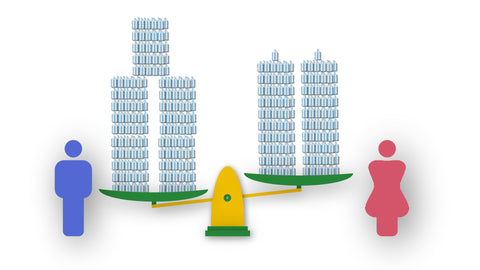7 Interesting New Beverage Takeaways from USDA and HHS
Every 5 years, the U.S. Departments of Agriculture (USDA) and Health and Human Services (HHS) update the Dietary Guidelines for America. New guidelines form the basis of federal nutrition policy and resources for the following 5 years.
Starting in March 2019, an advisory committee reviewed the latest dietary and nutrition research to create their Scientific Report. The full report, published last month online, is over 800 pages and includes a chapter dedicated to beverages.
Trimino Brands break down 7 interesting new insights from the Scientific Report. Check out number 5 to find out how trimino - protein infused water can help you.
- Beverages are for more than slaking thirst.
- Americans guzzle a lot of beverages.
- Beverages are key to mental and physical performance.
- Beverages offset nutrient shortfalls.
- Americans don't drink their protein...yet
- Sugar Sweetened Beverages contribute the least nutrients.
- Low- and No-Calorie-Sweetened Beverages can aid weight loss.
1. Beverages are for more than slaking thirst.
The Scientific Report provides a pretty flowery explanation of how Americans use drinks.
"...beverages fulfill unique roles in the diet by fulfilling hydration needs, quenching thirst, and assisting with food mastication and digestion. In addition, culturally, beverages serve a unique role in enhancing social interactions, sensory properties of foods, and quality of life."
Mastication is a fancy way to say "chewing." According to the report, beverages are consumed at most "ingestive events." Basically, when we eat food, we usually wash it down with a nice beverage. But, that's not the only time Americans consume beverages. "They can be part of a meal or snack, consumed as “the” meal or snack, or “sipped” throughout the day with no discrete ingestive event." Beverages are pretty versatile.
2. Americans guzzle a lot of beverages.
Adults ages 20-64 intake 88 fl oz a day (or about 5 1/2 triminos). That's over 250 gallons a year. On average, men drink 17 fl oz a day more than women.

3. Beverages are key to mental and physical performance.
We need all those fluids to function our best. "Declines of only 2 percent of body water result in compromised cognitive and physical performance" This can occur rapidly, so its good to spread regular fluid intake throughout the day. Grab a trimino in the afternoon to boost your fluid intake and your energy.
4. Beverages offset nutrient shortfalls.
Drinks are a great way to sneak more nutrients into your diet. In fact, many americans are already drinking their way to a healthy diet.
According to the Scientific Report, 100% Fruit Juices and Milk provide at least 1/3 of the shortfalls of nutrients like vitamin C, vitamin D, and calcium. In adults ages 20 to 64 years, beverages also contribute about 20 percent to the daily intake of potassium.
Each time you pick up a beverage, it's a chance to swallow some essential nutrients. trimino is packed with vitamins B3, B5, B6, and B12.

5. Americans don't drink their protein...yet
 If you are looking to increase your protein intake, to supplement shortfalls or pump up muscles, protein infused beverages can help. Each bottle of trimino - protein infused water packs 7 grams of whey protein isolate about 14% of the daily recommendation. Unlike a steak dinner, it's easy to toss a trimino in your backpack, briefcase, or purse.
If you are looking to increase your protein intake, to supplement shortfalls or pump up muscles, protein infused beverages can help. Each bottle of trimino - protein infused water packs 7 grams of whey protein isolate about 14% of the daily recommendation. Unlike a steak dinner, it's easy to toss a trimino in your backpack, briefcase, or purse.
6. Sugar Sweetened Beverages contribute the least nutrients.
Sugar Sweetened Beverages (SSB) are beverages that contain added sugar. This is a broad category of drinks that excludes flavored milks, coffee, and teas, but includes soft drinks, fruit and vegetable juices that aren't 100% juice, sports and energy drinks and even protein powders that are consumed as drinks.
Pay attention to the balance of calories to nutrients in your beverages to make sure every drink you pick up is giving you the most bang for your buck.
7. Low- and No-Calorie-Sweetened Beverages can aid weight loss.
Low- and No-Calorie-Sweetened Beverages (LNCSB) are generally 'diet' drinks. LNCSB are sweetened with sugar alternatives that aid flavor but don't add calories. trimino - protein infused water falls into this category.
trimino original flavors use sucralose while the all-natural flavors use stevia. The Scientific Report found sufficient evidence "to acknowledge such beverages may be a useful aid in weight management in adults."
trimino - protein infused water has 7 grams of protein, 100% of 4 B vitamins and only 28 calories.
For more information on the current dietary guidelines visit https://www.dietaryguidelines.gov/
What's the difference between the Scientific Report and the Dietary Guidelines for Americans? The Scientific Report is a review of available nutrition science by nutrition experts. Once completed, that report is sent to USDA and HHS. USDA and HHS use the Scientific Report to create nutrition recommendations. Those recommendations form the new Dietary Guidelines for Americans.
